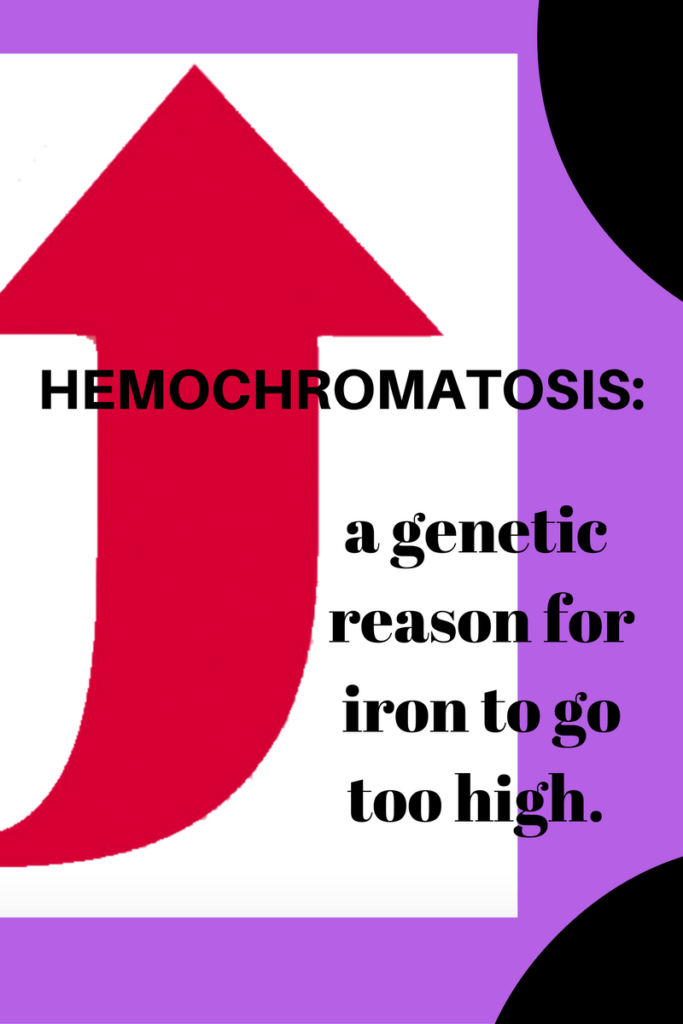In my work as a thyroid patient activist, I occasionally see someone who has the condition called Hemochromatosis. It’s an inherited autosomal recessive disease of iron overload and is progressive. And patients were first clued in when they saw high levels of the combination of iron, % saturation AND ferritin. All three. I have one genetic copy for hemochromatosis, but it’s not active. Other’s can have an active mutation. ~Janie, hypothyroid patient and creator of this patient-to-patient site
So my first clue for Hemochromatosis is in iron tests?
Yes! Those with hemochromatosis can tend to be high in ALL THREE iron labs i.e. serum iron, % saturation and ferritin. And in most, we see the TIBC (IBC) quite low when those are high. (Note that iron can be high with a methylation problem, too, but the TIBC is usually high with a methylation problem, whereas for most with hemochromatosis, it’s lower.)
What is a more definitive test for my doctor to diagnose it?
Genes involved in having the Hemochromatosis mutation are C282Y and H63D, with the former being the most common. From http://www.medicinenet.com/iron_overload/page3.htm:
A C282Y homozygote is a person who has inherited one mutated C282Y gene from each parent. A C282Y homozygote is considered at risk of developing iron overload. In fact, C282Y homozygotes account for 95% of all hereditary hemochromatosis. Conversely, not every C282Y homozygote develops iron overload. Studies have shown that an estimated 50% of C282Y homozygotes may not develop iron overload or its complications.
A C282Y/H63D compound heterozygote is a person who has inherited one mutated C282Y gene from one parent and a second mutated H63D gene from the other parent. Most compound heterozygotes have normal iron levels though some can develop mild to moderate iron overload.
A C282Y heterozygote is a person who has inherited one mutated C282Y gene from one parent but a second normal HFE gene from the other parent. Children born of two C282Y heterozygotes have a 25% chance of being a C282Y homozygote and, therefore, will be at risk of developing hemochromatosis. A C282Y heterozygote does not develop iron overload.
More testing information here in the article titled Iron Binding Saturation and Genotypic Testing for Hereditary Hemochromatosis in Patients With Liver Disease Or on livewello.com where you have uploaded your 23andme.com data, search for HFE…then search all the rs numbers by clicking on them.
Liver damage may be a sign of hemochromatosis. So doctors will also test liver signs like ALT and others. An MRI scan can show the amount of iron in your liver.
Why is hemochromatosis a concern?
Because it’s progressive and can damage one’s endocrine organs, heart, joints, liver, and pancreas.
How did I get this?
Hemochromatosis is an inherited disorder, i.e. if you have it, it’s highly likely you have ancestors with it. It’s also said to occur mostly in Caucasians.
Are there symptoms?
Not always. You might have few if any symptoms for awhile. But symptoms could then appear, such as darkening of your skin, fatigue or weakness, liver problems revealed by labs, heart issues such as an irregular heartbeat, joint pain. Some even report stomach pain.
And this abnormal accumulation of iron can be very dangerous if not discovered, lowered and kept in check. It will usually over-accumulate in your joints, heart, liver, pituitary…and in men, the testicles.
Could I have had this a long time?
Yes, some individuals could go decades without even knowing they have this problem if they never tested iron, making it all the more dangerous. It could lead to liver cirrhosis and an increased risk of developing cancer in your liver, say experts.
For a more definitive diagnosis, a doctor may order a biopsy of your liver i.e. the removal of tissue which will be tested. But simply doing genetic testing can reveal it.
How do I treat hemochromatosis?
Your doctor will recommend simply giving blood, called phlebotomy, and can occur every few months to keep your iron levels under control. Patients are often told to avoid Vitamin C, since it increases iron absorption.
***This is also why it’s recommended to at least test your iron levels yearly…just in case you have this disorder.
What if only my iron and % saturation are high, and ferritin is low?
That may not be hemochromatosis. Having a MTHFR or other methylation mutation can cause iron to go too high, but usually it’s just serum iron and % saturation that’s high with a methylation problem, while ferritin is low. A methylation problem puts us in a low iron state, because with the mutation, we aren’t breaking the iron down for use. With the methylation cause, we also see a much higher TIBC (IBC) then we do for hemochromatosis.
To read about BOTH hemochromatosis vs MTHFR, go here.
Important notes: All the information on this website is copyrighted. STTM is an information-only site based on what many patients worldwide have reported in their treatment and wisdom over the years. This is not to be taken as personal medical advice, nor to replace a relationship with your doctor. By reading this information-only website, you take full responsibility for what you choose to do with the information on STTM or its outcomes. See the Disclaimer and Terms of Use.
